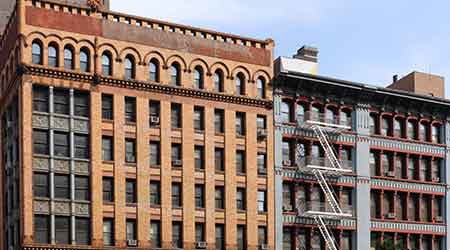5 Advantages of Direct Digital Controls (DDC) for Tenant Buildouts
DDCs offer increased occupant comfort and decreased operating costs, among other advantages.
In an interior buildout project, building tenants are faced with a myriad of architectural and engineering decisions. One of these is whether to use pneumatic or direct digital controls. Pneumatic controls use compressed air, taking a sensor input and translating that to an actuator output, all via air pressure. Digital controls offer the same functionality but, instead of using compressed air, electrical signals are sent from the sensor to the controller, controlling the actuator.
While the initial cost of DDC is greater than pneumatic controls, there are multiple benefits to consider when determining if the investment will provide adequate value and return on investment. As DDC technology progresses, more integrated solutions are also being developed, utilizing the data available through DDC to provide a more automated and efficient workplace.
Ultimately, each base building or tenant space will need to couple its independent requirements and budget parameters with a thorough understanding of the advantages and disadvantages of each.
DDC Controls: Comfort and Operating Costs
The integration of digital controls allows for remote monitoring of equipment at a centralized location. Other advantages of DDC controls include:
1. Increased occupant comfort. Due to the inherently faster response time of electrical signals to compressed air, digital controls provide a tenant with much tighter thermal comfort control. Because pneumatic systems use compressed air to operate actuators which move valves and dampers, they are overall less accurate.
2. Decreased operating costs and faster response time. Remote monitoring of DDC controls means facilities personnel can view and change HVAC status and set points — including damper and valve positions, heating stages, and space temperature set points — from afar. If there is a problem with equipment, facility staff can troubleshoot remotely before the tenant is aware there is an issue and don’t have to physically check on the equipment. This frees up staff time to attend to other building needs. With pneumatics, if there is an equipment failure, the facility staff will be unaware of it until the decreased building performance is noticed or they receive tenant complaints. Once an engineer is aware of the failure, he or she would have to physically go to the equipment to inspect and repair it.
3. Controls sequences for energy savings. When a base building system is provided with DDC controls, sequences of operations can be programmed to control equipment in a more optimized manner. Sensors monitor multiple conditions and can change operation to decrease energy consumption. Some typical programmed sequences are optimum start/stop modes, economizer modes, and temperature reset schedules.
4. Digital interface. Since DDC controls interface with a building’s automation system (BAS), engineers can tap into the diagnostics from their central location through a digital interface. Depending on the building, contractors can attach digital points from standalone tenant equipment to the building BAS. This allows tenants to have 24/7 monitoring of their equipment, such as a server room cooling unit. For example, if there was ever an afterhours leak or failure of equipment causing the temperature to elevate in the server room, the base building would get an alarm and be able to address the issue and notify the tenant.
5. Less tenant maintenance required. With DDC controls, a building engineer’s time is spent less on tenant equipment and more on the base building systems. Building engineers have an extensive list of tasks required to keep the building running. The less time they spend addressing tenant issues, the more time they have to focus on continuous operation of the building and to conduct preventive maintenance on the more complex base building systems. This in turn allows the base building systems to run more efficiently.
Related Topics:











